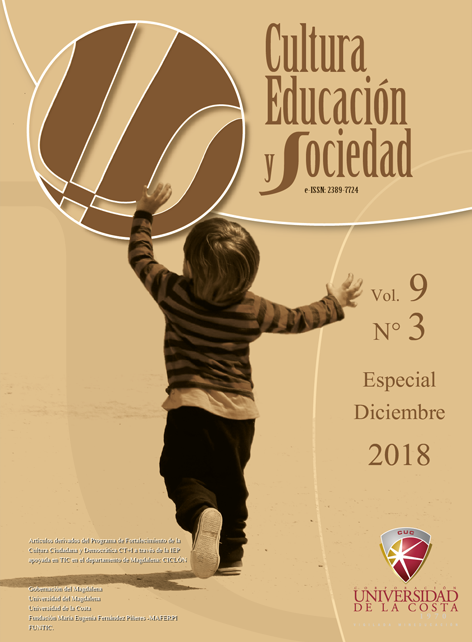Collaborative learning as didactic strategies for the improvement of reading comprehension
DOI:
https://doi.org/10.17981/cultedusoc.9.3.2018.13Keywords:
Didactic strategy, Collaborative Learning, Reading Comprehension.Abstract
Collaborative learning becomes an instrument of practical knowledge that favors knowledge appropriation spaces not only for students but also for the educational community in general. This research seeks to show the processes of reading comprehension, in the students of the Educational Institution of Our Lady of Carmen, fostering teaching tools such as collaborative learning that enhances the motivation for reading. The present study is carried out from a quantitative perspective, from a descriptive scope. The population intervened were elementary school students. As results, it was possible to observe that group or collaborative work can not only increase academic performance, but also presents other virtues such as that the student learns to work in a team and the interactive learning model assumes that classroom experiences must overcome the memoristic and mechanistic learning.
Downloads
References
Abreu, R. (1994). Modelo Teórico básico de la pedagogía profesional. La Habana.
Avendaño, Cortés O , Guerrero H. ( 2015) Competencias sociales y tecnologías de la información y la comunicación como factores asociados al desempeño en estudiantes de básica primaria con experiencia de desplazamiento forzado Diversitas: Perspectivas en Psicología, vol. 11, núm. 1, 2015, pp. 13-36 Universidad Santo Tomás Bogotá, Colombia.
Brufee, K. (1994). Collaborative Learning: Higher Education, Interdependence and the Authority of Knowledge. Baltimore: Johns Hopkins Press.
Brufee, K. (1995). Sharing our toys - Cooperative learning versus collaborative learning: Change, Jan/Feb, 12-18.
Bugueño, X. Barros, C. (2008). Fichas docentes. Formación e equipos de trabajo colaborativo. Valoras UC. Bogotá: Ministerio de Educación.
Cabero, J. (2003). Principios pedagógicos, psicológicos y sociológicos del trabajo colaborativo: su proyección en la telenseñanza. Paidós Ibérica. In Redes de comunicación en la enseñanza: las nuevas perspectivas del trabajo corporativo (pp. 129-156).
Cabero., J. (2003). Principios pedagógicos, psicológicos y sociológicos del trabajo colaborativo: su proyección en la tele enseñanza. En Martínez, F. (Compiladores) 2003. Redes de comunicación en la enseñanza. Las nuevas perspectivas de trabajo corporativo. Barcelona. Paidós.
Carrasco, J. (1997). Técnicas y recursos para el desarrollo de las clases. Editores: Madrid Rialp tercera edición.
Carrasco, J. (2004). Una didáctica para hoy: cómo enseñar mejor. Ediciones Rialp.
Castellaro, M., y Dominino, M. (2011). El proceso colaborativo en niños de escolaridad inicial y primaria. Una revisión de trabajos empíricos. Revista Intercontinental de Psicología y Educación. vol. 13, núm. 2, julio-diciembre, 2011, pp. 119-145 Universidad Intercontinental Distrito Federal, México
Cerda, H. (1998). Los elementos de la investigación. Bogota: El Buho.
Chavarria, Maria Cecilia (1985).desarrollo ya atención en niños de 7 a 12 años. Editorial universidad estatal a distancia. sanjose costa rica 1985
Collazos, C., Guerrero, L., & Vergara, A. (2001). Aprendizaje Colaborativo: un cambio en el rol del profesor. In Proceedings of the 3rd Workshop on Education on Computing, Punta Arenas, Chile.
Curiche, D. (2015). Desarrollo de habilidades de pensamiento crítico por medio de aprendizaje basado en problemas y aprendizaje colaborativo mediado por computador. Tesis inédita de maestría. Universidad de Chile, Santiago de Chile.
Díaz, F, & Hernández, G. (1998). Estrategias docentes para un aprendizaje significativo. Editorial Mc Graw Hill. México.
Feo, R. (2010). Orientaciones Básicas Para El Diseño De Estrategias Didacticas. Tendencias Pedagogicas(16), 219-236.
Godat, M. (2012). Collaborative Learning and Critical Thinking in Technology-enhanced Environments. Tesis para optar el título de Doctor en Filosofia en Universidad de Tecnología de Queensland.
Gros, B (2013). Aprender y enseñar en colaboración. En Aprender en Red. Suárez, C. y Gros B. Editorial UOC.
Marín, F., Inciarte, A., Hernández, H., y Pitre, R. (2017). Estrategias de las instituciones de educación superior para la integración de las tecnologías de la información y la comunicación y de la innovación en los procesos de enseñanza. Un estudio en el distrito de Barranquilla, Colombia
Romero-Acosta, K., & Contreras Banques, E. (2015). Revisión teórica sobre el post-conflicto: una oportunidad para empoderar a mujeres víctimas de desplazamiento. Cultura Educación y Sociedad, 6(1). Recuperado a partir de https://revistascientificas.cuc.edu.co/culturaeducacionysociedad/article/view/757
Downloads
Published
How to Cite
Issue
Section
License
Copyright (c) 2018 CULTURA EDUCACIÓN Y SOCIEDAD

This work is licensed under a Creative Commons Attribution-NonCommercial-NoDerivatives 4.0 International License.
![]()
Creative Commons 2020 CULTURA EDUCACIÓN Y SOCIEDAD
This article is under international license Creative Commons Reconocimiento-NoComercial-SinObrasDerivadas 4.0.
The published articles are the sole responsibility of their authors and do not necessarily reflect the opinions of the editorial committee.
CULTURA EDUCACIÓN Y SOCIEDAD respects the moral rights of its authors, who assign to the editorial committee the patrimonial rights of the published material. In turn, the authors inform that this work is unpublished and has not been previously published.
All articles are under a:
Licencia Creative Commons Atribución-NoComercial-SinDerivadas 4.0 Internacional.
![]()


 English
English
 Español (España)
Español (España)




_12.53_.27_p_. m_._3.png)





_12.57_.35_p_. m_._3.png)
_12.50_.37_p_. m_._3.png)



